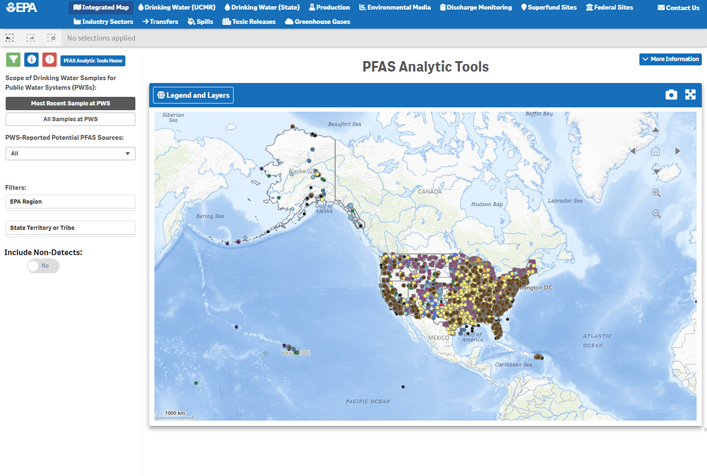PFAS Analytic Tools

Project Brief
The Challenge
Often called “forever chemicals,” per- and polyfluoroalkyl substances (PFAS) are highly persistent in the environment but have not historically been subject to environmental regulations. Until 2021, few federal or state environmental programs required reporting of PFAS use or monitoring of PFAS releases, and no nationwide surveillance programs generated data on the occurrence of PFAS in the environment. PFAS data that did exist were typically housed in widely distributed data systems, not standardized, and not accessible on a national scale. Recently, the U.S. Geological Survey, U.S. Environmental Protection Agency, and several states have undertaken broad investigations of PFAS occurrence in the environment and drinking water supplies. To increase transparency and improve understanding of the use, releases, and risks associated with PFAS, EPA’s PFAS Action Plan called for a centralized data repository to facilitate public access to current information and wide-ranging analyses. EPA selected ERG to support the development, launch, and maintenance of this repository.
ERG's Solution
ERG worked with EPA to develop the PFAS Analytic Tools—an interactive, place-based data platform first released to the public in 2023. Hosted on EPA’s Enforcement and Compliance History Online (ECHO) website, these web tools consolidate data from 12 national-scale sources, offering current, geographically specific information on PFAS production, use, release, and occurrence. Working closely with EPA at every stage, our multi-disciplinary team of environmental scientists, software developers, policy analysts, and data visualization experts supported EPA by:
- Researching and documenting relevant data sources, including automating data retrieval.
- Developing protocols to standardize and integrate diverse data types across EPA systems and other public datasets, while clearly communicating the scope and limitations of the available data through tool disclaimers and user guidance.
- Supporting integration of key PFAS lifecycle information, including production, imports/exports, handling, releases, spills, discharge monitoring, waste management, contaminated media, and drinking water occurrence.
- Designing and building the tool’s interactive public interface using Qlik, enabling custom filtering, mapping, and time-based exploration.
- Presenting key findings through summary tables, charts, scatter plots, treemaps, and other visual formats.
- Continuing to maintain and expand the platform, including incorporating new data sources and ensuring weekly data refreshes.
The PFAS Analytic Tools have become a trusted resource for communities, researchers, and government officials working to understand and respond to PFAS contamination.
Client
U.S. Environmental Protection Agency